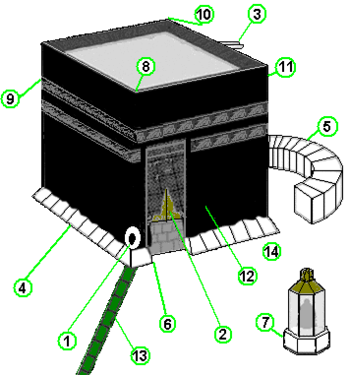
Kaaba
From Wikipedia, the free encyclopedia

| Kaaba (Ka'aba) | |
|---|---|
| الكعبة | |
The Kaaba Sharif
| |
| Basic information | |
| Location | Mecca, al-Hejaz, Saudi Arabia |
| Geographic coordinates | 21.4225°N 39.826181°ECoordinates: 21.4225°N 39.826181°E |
| Affiliation | Islam |
| Height (max) | 13.1 m (43 ft) |
The Kaaba or Ka'aba (Arabic: الكعبة al-Kaʿbah IPA: [ælˈkæʕbɐ], "The Cube") is a cuboid building at the center of Islam's most sacred mosque, Al-Masjid al-Haram, in Mecca, Saudi Arabia. It is the most sacred site in Islam.[1] It is considered the "House of God" and has a similar role as the Tabernacle andHoly of Holies in Judaism and Christianity. Wherever they are in the world,Muslims are expected to face the Kaaba when performing salat (prayer). From any point in the world, the direction facing the Kaaba is called the qibla.
One of the Five Pillars of Islam requires every Muslim who is able to do so to perform the hajj pilgrimage at least once in their lifetime. Multiple parts of thehajj require pilgrims to make tawaf, the circumambulation seven times around the Kaaba in a counter-clockwise direction. Tawaf is also performed by pilgrims during the umrah (lesser pilgrimage).[1] However, the most interesting times are during the hajj, when millions of pilgrims gather to circle the building on the same day.[3][4] In 2013, the number of pilgrims coming from outside the Kingdom of Saudi Arabia to perform hajj was officially reported as 1,379,531.[5] In 2014, Saudi Arabia reported having completed Hajj permits for 1,389,053 international pilgrims and 63,375 for residents.[6]
Lexicology[edit]
The building is called by many names in the Quran and Hadith, such as Bait (House), Bait ul Haram (Sacred House), Bait Ullah (House of Allah), Bait al-Ateeq (Ancient House), Awal ul Bait (First House) and Kaabah. The Arabic word Bait is cognate to the Hebrew Bet as used in for example Bet HaMikdash (Holy House) and Beit El (House of God). The Arabic word Kaaba means square or cube.[7][8] The Quran also mentions Bait al-Ma'mur,[Quran 52:4] the House of God in Heavens which the Kaaba symbolizes, where according to Hadith the Angels perform Tawaf and Prayers.[9][10]
Architecture and interior[edit]
The Kaaba is a bricked cuboid structure which is made of granite quarried from nearby Kyara Land. The Kaaba is approximately 13.1 m (43 ft) high (some claim 12.03 m (39.5 ft)), with sides measuring 11.03 m (36.2 ft) by 12.86 m (42.2 ft).[11][12] Inside the Kaaba, the floor is made of marble and limestone. The interior walls, measuring 13 m (43 ft) by 9 m (30 ft), are clad with tiled, white marble halfway to the roof, with darker trimmings along the floor. The floor of the interior stands about 2.2 m (7.2 ft) above the ground area where tawaf is performed.
The wall directly adjacent to the entrance of the Kaaba has six tablets inlaid with inscriptions, and there are several more tablets along the other walls. Along the top corners of the walls runs a green cloth embroidered with gold Qur'anic verses. Caretakers anoint the marble cladding with the same scented oil used to anoint the Black Stone outside. Three pillars (some erroneously report two) stand inside the Kaaba, with a small altar or table set between one and the other two. (It has been claimed that this table is used for the placement of perfumes or other items.) Lamp-like objects (possible lanterns or crucible censers) hang from the ceiling. The ceiling itself is of a darker colour, similar in hue to the lower trimming. A golden door—the Babut Taubah (also romanized as Baabut Taubah, and meaning "Door of Repentance")—on the right wall (right of the entrance) opens to an enclosed staircase that leads to a hatch, which itself opens to the roof. Both the roof and ceiling (collectively dual-layered) are made of stainless steel-capped teak wood.
Each numbered item in the following list corresponds to features noted in the diagram image, on right.
- Al-Ħajaru al-Aswad, "the Black Stone", is located on the Kaaba's eastern corner. Its northern corner is known as the Ruknu l-ˤĪrāqī, "the Iraqi corner", its western as the Ruknu sh-Shāmī, "the Levantine corner", and its southern as Ruknu l-Yamanī, "the Yemeni corner".[1][12] The four corners of the Kaaba roughly point toward the four cardinal directions of thecompass.[1] Its major (long) axis is aligned with the rising of the star Canopus toward which its southern wall is directed, while its minor axis (its east-west facades) roughly align with the sunrise of summer solstice and the sunset of winter solstice.[13][14]
- The entrance is a door set 2.13 m (7 ft) above the ground on the north-eastern wall of the Kaaba, which acts as the façade.[1] In 1979 the 300 kg gold doors made by chief artist Ahmad bin Ibrahim Badr, replaced the old silver doors made by his father, Ibrahim Badr in 1942.[15] There is a wooden staircase on wheels, usually stored in the mosque between the arch-shaped gate of Banū Shaybah and the Zamzam Well.
- Meezab-i Rahmat, rainwater spout made of gold. Added in the rebuilding of 1627 after the previous year's rain caused three of the four walls to collapse.
- Gutter, added in 1627 to protect the foundation from groundwater.
- Hatim (also romanized as hateem), a low wall originally part of the Kaaba. It is a semi-circular wall opposite, but not connected to, the north-west wall of the Kaaba known as the hatīm. This is 90 cm (35 in) in height and 1.5 m (4.9 ft) in width, and is composed of white marble. At one time the space lying between the hatīm and the Kaaba belonged to the Kaaba itself, and for this reason it is not entered during the tawaf. According to western scholars the space contains the remains of Hagar and Ishmael as it is called hidjr Ismail[16]
- Al-Multazam, the roughly 2 meter space along the wall between the Black Stone and the entry door. It is sometimes considered pious or desirable for a hajji to touch this area of the Kaaba, or perform dua here.
- The Station of Abraham, a glass and metal enclosure with what is said to be an imprint of Abraham's foot. Abraham is said to have stood on this stone during the construction of the upper parts of the Kaaba, raising Ismail on his shoulders for the uppermost parts.[17]
- Corner of the Black Stone (East).
- Corner of Yemen (South-West). Pilgrims traditionally acknowledge a large vertical stone that forms this corner.
- Corner of Syria (North-West).
- Corner of Iraq (North-East). This inside corner, behind a curtain, contains the Babut Taubah, Door of Repentance, which leads to a staircase to the roof.
- Kiswah, the embroidered covering. Kiswa is a black silk and gold curtain which is replaced annually during the Hajj pilgrimage.[18][19] Two-thirds of the way up is a band of gold-embroidered Quranic text, including the Shahada, the Islamic declaration of faith.
- Marble stripe marking the beginning and end of each circumambulation.
- The station of Gabriel.[20]
Religious significance[edit]
The Kaaba is the holiest site in Islam, and is often called by names such as the House of God or the House of Allah.[21][22]
Qibla[edit]
Main article: Qibla
The Qibla is the direction faced during prayer.[Quran 2:143–144] It is the focal point for prayer. The direction faced during prayer is the direction of where the Kaaba is.
Pilgrimage[edit]
The Haram is the focal point of the Hajj and Umrah pilgrimages[23] that occur in the month of Dhu al-Hijjah in the Islamic calendar and at any time of the year, respectively. The Hajj pilgrimage is one of the Pillars of Islam, required of all able-bodied Muslims who can afford the trip. In recent times, about 6 million Muslims perform the Hajj every year.[citation needed]
Some of the rituals performed by pilgrims are symbolic of historical incidents. For example, the incident of Hagar's search for water is emulated by Muslims as they run between the two hills of Safa and Marwah whenever they visit Mecca.
The Hajj is associated with the life of the Islamic prophet Muhammad from the 7th century, but the ritual of pilgrimage to Mecca is considered by Muslims to stretch back thousands of years to the time of Sayyidna Ibrahim (Abraham).
History[edit]
Traditional views on origin[edit]
The Quran contains several verses regarding the origin of the Kaaba, it states that the Kaaba was the first House of Worship, and that it was built or re-built by Abraham and Ishmael on God's instructions.
Ibn Kathir, the famous commentator on the Quran, mentions two interpretations among the Muslims on the origin of the Kaaba. One is that the shrine was a place of worship for Angels before the creation of man. Later, a temple was built on the location by Adam and Eve which was lost during the flood in Noah's time and was finally rebuilt by Abraham andIshmael as mentioned later in the Quran. Ibn Kathir regarded this tradition as weak and preferred instead the narration by Ali ibn Abi Talib that although several other temples might have preceded the Kaabah, it was the first "House of God", dedicated solely to Him, built by His instruction and sanctified and blessed by Him as stated in Quran 22:26–29.[27] AHadith in Sahih Bukhari states that the Kaaba was the First Mosque on Earth, and the Second Mosque was the Temple in Jerusalem.[28]
While Abraham was building the Kaaba, an angel brought to him the Black Stone which he placed in the eastern corner of the structure. Another stone was the Maqam-e-Ibrahim (literally the Station of Abraham) where Abraham stood for elevation while building the structure. The Black Stone and the Maqam-e-Ibrahim are believed by Muslims to be the only remnant of the original structure made by Abraham as naturally the remaining structure had to be demolished and rebuilt several times over history for maintenance purposes. After the construction was complete, God enjoined the descendants of Ishmael to perform an annual pilgrimage: the Hajj and the Korban, sacrifice of cattle. The vicinity of the shrine was also made a sanctuary where bloodshed and war were forbidden.[Quran 22:26–33]
According to Islamic tradition, over the millennia after Ishmael's death, his progeny and the local tribes who settled around the oasis of Zam-Zam gradually turned to polytheism and idolatry. Several idols were placed within the Kaaba representing deities of different aspects of nature and different tribes. Several heretical rituals were adopted in the Pilgrimage (Hajj) including doing naked circumambulation.[29]
In her book, Islam: A Short History, Karen Armstrong asserts that the Kaaba was at some point dedicated to Hubal, aNabatean deity, and contained 360 idols that probably represented the days of the year. In Guillaume's translation of Ibn Ishaq, an early biographer of Muhammad, the Ka'aba itself was addressed using a feminine grammatical form.[30]Circumambulation was often performed naked by men and almost naked by women,[29] and linked to ancient fertility rites.[31] By Muhammad's day, the Kaaba was venerated as the shrine of Allah, the High God. Once a year, tribes from all around the Arabian peninsula, whether Christian or pagan, would converge on Mecca to perform the Hajj, marking the widespread conviction that Allah was the same deity worshiped by monotheists.[32]
Modern independent views on origin[edit]
Writing in the Encyclopedia of Islam, Wensinck identifies Mecca with a place called Macoraba mentioned by Ptolemy and found in a 3rd-century BC map which suggests that Macoraba was Mecca.[33][34] In her book, Islam: A Short History,Karen Armstrong asserts that the Kaaba was at some point dedicated to Hubal, a Nabatean deity.
Imoti[35] contends that there were numerous such "Kaaba" sanctuaries in Arabia at one time, but this was the only one built of stone. The others also allegedly had counterparts of the Black Stone. There was a "red stone", the deity of the south Arabian city of Ghaiman, and the "white stone" in the Kaaba of al-Abalat (near the city of Tabala, south of Mecca). Grunebaum in Classical Islam points out that the experience of divinity of that period was often associated with stone fetishes, mountains, special rock formations, or "trees of strange growth."[36]
The Kaaba was thought to be at the center of the world, with the Gate of Heaven directly above it. The Kaaba marked the location where the sacred world intersected with the profane; the embedded Black Stone was a further symbol of this as a meteorite that had fallen from the sky and linked heaven and earth.[37]
According to Sarwar,[38] about 400 years before the birth of Muhammad, a man named "Amr bin Lahyo bin Harath bin Amr ul-Qais bin Thalaba bin Azd bin Khalan bin Babalyun bin Saba", who was descended from Qahtan and was the king of Hijaz had placed a Hubal idol onto the roof of the Kaaba. This idol was one of the chief deities of the ruling Quraysh. The idol was made of red agate and shaped like a human, but with the right hand broken off and replaced with a golden hand. When the idol was moved inside the Kaaba, it had seven arrows in front of it, which were used for divination.[39]
To maintain peace among the perpetually warring tribes, Mecca was declared a sanctuary where no violence was allowed within 20 miles (32 km) of the Kaaba. This combat-free zone allowed Mecca to thrive not only as a place of pilgrimage, but also as a trading center.[40]
The Greek historian Diodorus Siculus is believed to have mentioned the Kaabah in 60–30 BC while describing the coast of Jeddah and its surrounding areas mentioned:
Edward Gibbon suggested that the Kaaba was mentioned by ancient Greek writer, Diodorus Siculus, before the Christian era:
In Makkan Trade and the Rise of Islam, Patricia Crone argues that the identification of Macoraba with Mecca is false and that Macoraba was a town in southern Arabia in what was then known as Arabia Felix.[42]
Crone was responded to by Amaal Muhammad Al-Roubi in "A Response to Patrica Crone's book".[43]
G. E. von Grunebaum states:
Many Muslim and academic historians stress the power and importance of the pre-Islamic Mecca. They depict it as a city grown rich on the proceeds of the spice trade. Crone believes that this is an exaggeration and that Mecca may only have been an outpost trading with nomads for leather, cloth, and camel butter. Crone argues that if Mecca had been a well-known center of trade, it would have been mentioned by later authors such as Procopius, Nonnosus, or the Syrian church chroniclers writing in Syriac. The town is absent, however, from any geographies or histories written in the three centuries before the rise of Islam.[44]
According to the Encyclopædia Britannica, "before the rise of Islam it was revered as a sacred sanctuary and was a site of pilgrimage."[45] According to German historian Eduard Glaser, the name "Kaaba" may have been related to the southern Arabian or Ethiopian word "mikrab", signifying a temple.[34] Again, Crone disputes this etymology.
In Samaritan literature, the Samaritan Book of the Secrets of Moses (Asatir) claims that Ishmael and his eldest sonNebaioth built the Kaaba as well as the city of Mecca.[46] "The Secrets of Moses" or Asatir book was suggested by some opinion to have been compiled in the 10th century,[47] while another opinion in 1927 suggested that it was written no later than the second half of the 3rd century BC.[48]
Muhammad's era[edit]
During Muhammad's time (570–632 CE), the Kaaba was considered a holy and sacred site by the local Arabs and Islam recognized it. Muhammad took part in the reconstruction of the Kaaba after its structure was damaged due to floods around 600 CE. Ibn Ishaq's Sirat Rasūl Allāh, one of the biographies of Muhammad (as reconstructed and translated by Guillaume), describes Muhammad settling a quarrel between Meccan clans as to which clan should set the Black Stone cornerstone in place. According to Ishaq's biography, Muhammad's solution was to have all the clan elders raise the cornerstone on a cloak, after which Muhammad set the stone into its final place with his own hands.[50][51] Ibn Ishaq says that the timber for the reconstruction of the Kaaba came from a Greek ship that had been wrecked on the Red Sea coast at Shu'ayba and that the work was undertaken by a Coptic carpenter called Baqum.[52] Muhammad's night journey is said to have taken him from the Kaaba to the Temple Mount and upwards heavens from there.
Muslims initially considered Jerusalem as their qibla and faced that direction while offering prayers, however pilgrimage to the Kaaba was considered a religious duty though its rites were not yet finalized. During the first half of Muhammad's time as a prophet while he was at Mecca, he and his followers were severely persecuted which eventually lead to their migration to Yathrib in 622 CE. In 624 CE the direction of the Qiblah(Prayer Direction) was changed from Jerusalem to the Kaabah in Mecca.[53] In 628CE Muhammad led a group of Muslims towards Mecca with the intention of performing the minor pilgrimage (Umrah) at the Kaaba, though he wasn't allowed by the people of Mecca to do so, he secured a peace treaty with them called the Treaty of Hudaybiyyah, which allowed the Muslims to freely perform pilgrimage at the Kaaba from the following year.[54]
At the culmination of his mission, in 629 CE, Muhammad conquered Mecca with a Muslim army.[55] His first action was to cleanse the Kaaba of idols and images.
After the conquest Muhammad restated the sanctity and holiness of Mecca and the Masjid ul Haram in Islam.[56] He performed a lesser Pilgrimage (Umrah) in 629 CE, followed by the Greater Pilgrimage(Hajj) in 632 CE called the Farewell Pilgrimage since Muhammad prophesied his impeding death on this event.[57]
After Muhammad[edit]
The Kaaba has been repaired and reconstructed many times since Muhammad's day. The structure was severely damaged by fire on 3 Rabi I (Sunday, 31 October 683), during the first siege of Mecca in the war between the Umayyadsand Abd-Allah ibn al-Zubayr, an early Muslim who ruled Mecca for many years between the death of ʿAli and the consolidation of Umayyad power. Ibn al-Zubayr rebuilt it to include the hatīm.[58] He did so on the basis of a tradition (found in several hadith collections[59]) that the hatīm was a remnant of the foundations of the Abrahamic Kaaba, and that Muhammad himself had wished to rebuild so as to include it.
The Kaaba was bombarded with stones in the second siege of Mecca in 692, in which the Umayyad army was led by al-Hajjaj ibn Yusuf. The fall of the city and the death of Ibn al-Zubayr allowed the Umayyads under ʿAbdu l-Malik ibn Marwan to finally reunite all the Islamic possessions and end the long civil war. In 693 AD, ʿAbdu l-Malik had the remnants of al-Zubayr's Kaaba razed, and rebuilt on the foundations set by the Quraysh.[60] The Kaaba returned to the cube shape it had taken during Muhammad's time.
During the Hajj of 930 AD, the Qarmatians attacked Mecca, defiled the Zamzam Well with the bodies of pilgrims and stole the Black Stone, taking it to the oasis region of Eastern Arabia known as al-Aḥsāʾ, where it remained until the Abbasids ransomed it in 952 AD. The basic shape and structure of the Kaaba have not changed since then.[61]
After heavy rains and flooding in 1629, the walls of the Kaaba collapsed and the Masjid was damaged. The same year, during the reign of Ottoman Emperor Murad IV, the Kaaba was rebuilt with granite stones from Mecca and the Masjid was renovated.[62] The Kaaba's appearance has not changed since then.
Cleaning[edit]
The building is opened twice a year for a ceremony known as "the cleaning of the Kaaba." This ceremony takes place roughly thirty days before the start of the month of Ramadan and thirty days before the start of Hajj.
The keys to the Kaaba are held by the Banī Shayba (بني شيبة) tribe. Members of the tribe greet visitors to the inside of the Kaaba on the occasion of the cleaning ceremony. A small number of dignitaries and foreign diplomats are invited to participate in the ceremony.[64] The governor of Mecca leads the honoured guests who ritually clean the structure, using simple brooms. Washing of the Kaaba is done twice a year with a mixture made from the Zamzam water, Taif rosewater and expensive Oud oilthat is traditionally used in Arabian perfumes.[65][66]



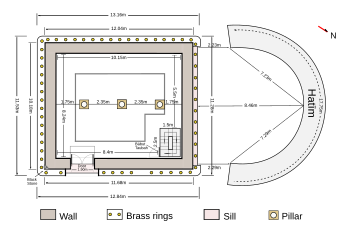

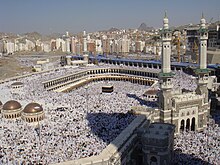

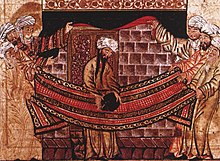

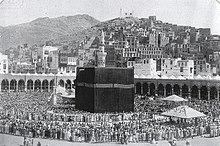

No comments:
Post a Comment